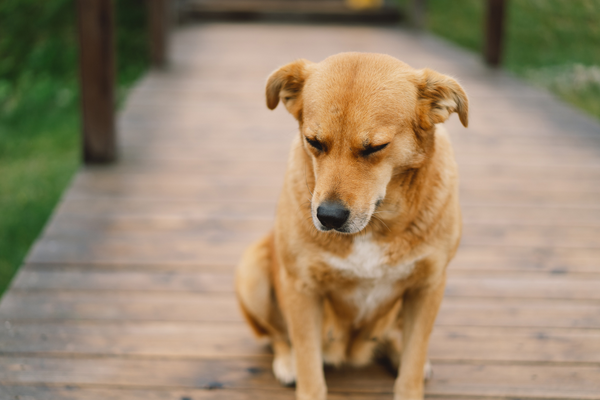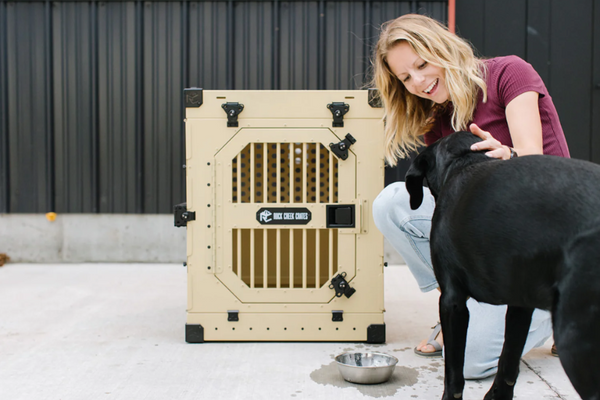According to Veterinarians.org, as many as one in every four to six dogs are affected by separation anxiety. If this is something you and your dog struggle with, it can be comforting to know that you’re certainly not alone. As a matter of fact, 20 to 40% of dogs and their pet parents in the United States are facing the same struggle. Separation anxiety is one of the most common behavioral challenges in dogs, but there are things that pet parents can do to help make their dogs (and themselves by extension) more comfortable. Learning how to crate train a dog with separation anxiety is one such strategy that can provide a great deal of benefit.
What Is Separation Anxiety?
According to the American Kennel Club, separation anxiety is defined as a condition where dogs experience extreme stress when separated from their owners. According to animal behaviorist Dr. Patricia McConnell Ph.D, when experiencing separation anxiety your dog may be having some of the same feelings humans experience when suffering a panic attack.

Separation anxiety most often develops within the first two years of life, according to the University of Illinois College of Veterinary Medicine. However, this isn’t standard across the board. In some instances, and especially through trauma, dogs may develop separation anxiety later in life. During the Covid-19 pandemic, for instance, one surprising thing that some dog owners found out was that their older dogs developed separation anxiety they didn’t seem to have before. Dogs spent long periods of time with their owners working from home, and when the pandemic ended and it was time to go back to the office, they were once again faced with separation they were no longer used to. Pet parents new to separation anxiety were left with a new challenge and new behaviors they never had to deal with before.
Older rescue dogs may also carry separation anxiety with them that has developed later in life. The passing of their pet parent, or feelings of abandonment, may lead to older rescue dogs developing this anxiety they may not have had in their younger years.
Symptoms Of Separation Anxiety In Dogs
If you’re unsure if your dog experiences separation anxiety, there are a number of signs or symptoms to look out for. According to the ASPCA, these include:
• Inappropriately relieving themselves – Dogs naturally do not want to “go” where they eat, sleep, and play. If a dog who is typically otherwise reliably housebroken has accidents in the home whenever you leave, it could be due to the anxiety they’re feeling being away from you.
• Howling and barking – If you get calls or notes from the neighbors about your dog being particularly noisy each time you leave the house, this is a common sign of separation anxiety. The barking and howling associated with anxiety is often consistent, and it’s the dog’s way to express or relieve the stress they’re feeling.
• Destructive behaviors – When dogs are feeling anxious or uncomfortable, they may take up some undesirable (or even dangerous) behaviors in an effort to soothe themselves. Dogs with separation anxiety may dig, chew, or otherwise destroy objects around the home or the structure of your home itself. It’s not rare for a dog to go to extremes, like chewing apart a doorframe or a large piece of furniture, during a separation anxiety episode. Not only are these destructive behaviors expensive and damaging to your home, but they can also pose a risk of broken teeth, choking, or gastrointestinal obstructions for your dog.
• Trying to escape – When experiencing those big feelings of anxiety, dogs go through a “fight of flight” response just like people do. Because your dog can’t “fight” being alone, they may choose the flight route instead, prompting them to attempt to escape from a room, a crate, or your home. This can lead dogs to claw and chew through doors or windows in an attempt to escape. Without a sturdy and chew-proof crate they can be kept safe in, this instinct may lead your dog to injure themselves in their escape or attempt to escape.
What Pet Parents Can Do
Pet parents can help their younger dogs to avoid developing separation anxiety, and they can help their dogs to cope with the anxiety comfortably if they should develop the condition for any reason. Those with older rescue dogs who have unknown histories can even help these pups to feel more comfortable no matter the severity of the anxiety or what may have caused it.
According to PetMD, the main goal pet parents of dogs with separation anxiety should have is to help the dog feel less dependent on your presence, and to increase comfort during times when they will be alone. Dogs should be encouraged to relax, and even rewarded when they will be without you for any length of time. This can help them to cope with being away from you, and in some instances, perhaps even look forward to it. It’s important to remember that separation anxiety is a complex process with complex feelings for your dog, and overcoming separation anxiety is possible with patience.
Puppy owners can encourage certain behaviors and exposures early on to make separation anxiety less likely to develop. According to Blue Cross UK, building confidence in puppies with frequent positive social interactions and rewarding your puppy with special toys or treats during short times spent alone can build a positive association with separation early on.
The Crate Is Key To Safety And Comfort For Dogs With Separation Anxiety
For pet parents of dogs with separation anxiety, you can’t expect to never be away from your dog for any reason. You may have to run errands, go into the office, go out with friends, or even take a vacation. Because of this, finding a solution that emphasizes safety and comfort is a top priority. Learning how to crate train a dog with separation anxiety is one of the best things you can do for you and your dog.

According to WAG!, when introduced properly, a crate is a natural comfort space for your dog. As den animals, dogs have an instinct to relax and feel safe when in small, cozy, private spaces – like a crate. For dogs with separation anxiety, this comfort space becomes a refuge where they can find relief from their anxious feelings. Learning how to crate train a dog with separation anxiety will take patience, but the work pays off tenfold for dogs and their pet parents in comfort and peace of mind.
Learning how to crate train a dog with separation anxiety is a multi-step process, but each step makes a great deal of sense:
• Find a sturdy, safe, and comfortable crate – For dogs with separation anxiety, not just any crate will do. When they feel anxious, they may act out with destructive or escaping behaviors, and you don’t want them to harm themselves in an attempt to escape their crate if those big feelings hit. A durable, scape proof, and chew-proof crate is key to ensuring a successful and safe experience.
• Build a positive association with the crate – First and foremost, you want your dog to view the crate as a positive thing. Set the crate up in a quiet area of the home and allow your dog to get comfortable with the presence of the crate on their own terms. When the dog investigates the crate or gets close to it, follow the action with praise.
• Encourage interaction with the crate – Once your dog gets used to the presence of the crate, you can encourage them to interact with it. Tossing a treat or favorite toy into the crate and rewarding your dog with plenty of praise when they go inside to retrieve it, is a great way to further progress this positive association.
• Bring comfort and positivity into the crate – While at home, you can make the crate the kind of place your dog wants to relax in by bringing comfort and positivity to the space. This may mean adding a crate pad or blanket, keeping a few toys in the crate, or spending feeding times in the crate on a regular basis. Before leaving your dog in their crate while you’re not at home, you may want to remove these items if your dog is prone to destructive behaviors.
• Encourage door closed crate time – Once your dog is comfortable with “open door” crate time, it’s time to move on to closed door crate time. For dogs with separation anxiety, this can be the part of the process that requires the most patience. Wait until your dog is already in their crate, approach the crate with a treat, feed the treat, and slowly close the door with plenty of praise. Leave the door closed for any time between 15 and 30 seconds, then open the door and reward again. While the door is closed, don’t bring attention to your dog, and perhaps turn the other way to emphasize “separation”.
This is the crucial part of the crate training process. As your dog grows more comfortable, build up the time spent with the “door closed”, and gradually move further and further from the crate during this time. Eventually, you will be able to close the crate, walk out of the room, and return in some minutes to open the crate and reward with praise.

The Best Thing You Can Do For You And Your Dog
While there’s an investment of time involved with crate training a dog with separation anxiety, it’s one that will continue to pay off throughout your best friend’s life. As you continue to extend crate time, and continue to build these positive associations, you’ll gift your dog a space that allows them to feel safe, comfortable, and loved even when they can’t be by your side.

